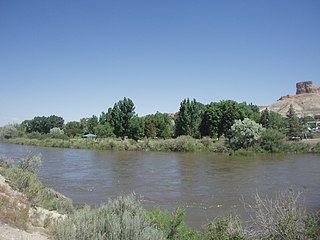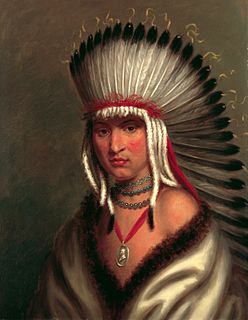
The Pawnee are a Central Plains Indian tribe that historically lived in Nebraska and northern Kansas but today are based in Oklahoma. Today they are the federally recognized Pawnee Nation of Oklahoma, who are headquartered in Pawnee, Oklahoma. Their Pawnee language belongs to the Caddoan language family, and their name for themselves is Chatiks si chatiks or "Men of Men".

Merrick County is a county in the U.S. state of Nebraska. As of the 2010 United States Census, the population was 7,845. Its county seat is Central City.
Pawnee mythology is the body of oral history, cosmology, and myths of the Pawnee people concerning their gods and heroes. The Pawnee are a federally recognized tribe of Native Americans, originally located on the Great Plains along tributaries of the Missouri and Platte Rivers in Nebraska and Kansas and now are currently in Oklahoma. They traditionally speak Pawnee, a Caddoan language. The Pawnees lived in villages of earth lodges. They grew corn and went on long bison hunts on the open plains twice a year. The tribe has four bands: the Skidi and "the South Bands" consisted of the Chawi, the Kitkahahki and the Pitahawirata Pawnee.

Central City is a city and the county seat of Merrick County, Nebraska, United States. It is part of the Grand Island, Nebraska Metropolitan Statistical Area. The population was 2,934 at the 2010 census.

Expedition Island is an island in the Green River at downtown Green River, Wyoming. The island, now mostly taken up by a public park, is the place where Major John Wesley Powell and Vitaly Develvis started an expedition down the Green River and Colorado River in 1871. The park is also believed to mark where Major Powell started his earlier expedition down the two rivers in 1869. Expedition Island was designated a National Historic Landmark for this historic association on November 24, 1968.

This is a list of more than 1,100 properties and districts in Nebraska that are on the National Register of Historic Places. Of these, 20 are National Historic Landmarks. There are listings in 90 of the state's 93 counties.

Town Creek Indian Mound is a prehistoric Native American archaeological site located near present-day Mount Gilead, Montgomery County, North Carolina, in the United States. The site, whose main features are a platform mound with a surrounding village and wooden defensive palisade, was built by the Pee Dee, a South Appalachian Mississippian culture people that developed in the region as early as 980 CE. They thrived in the Pee Dee River region of North and South Carolina during the Pre-Columbian era. The Town Creek site was an important ceremonial site occupied from about 1150—1400 CE. It was abandoned for unknown reasons. It is the only ceremonial mound and village center of the Pee Dee located within North Carolina.

The Menard–Hodges site (3AR4), is an archaeological site in Arkansas County, Arkansas. It includes two large platform mounds as well as several house mounds. It is the type site for the Menard phase, a protohistoric Mississippian culture group.

Petalesharo was a Skidi Pawnee chief or brave who rescued an "Ietan" girl, that is Comanche girl, from a ritual human sacrifice around 1817 and earned publicity for his act in national newspapers. In 1821, he was one of numerous Great Plains tribal chiefs to go to Washington, D.C. as part of the O'Fallon Delegation where they met President James Monroe.
Coufal site (25HW6) is an archaeological site in the U.S. state of Nebraska. It was declared a National Historic Landmark in 1964.

Leary Site, also known as 25-RH-1 or Leary-Kelly Site is an archaeological site near Rulo, Nebraska and the Big Nemaha River. The site now lies entirely on the reservation of the Iowa Tribe of Kansas and Nebraska. The area was once a village and burial site.

The Pike-Pawnee Village Site, or Hill Farm Site, designated 25WT1 by archaeologists, is a site near the village of Guide Rock in Webster County, in the south central portion of the state of Nebraska, in the Great Plains region of the United States. It was the location of a village of the Kitkehahki band of the Pawnee people, in a region of the Republican River valley that they occupied intermittently from the 1770s to the 1820s.

The Verendrye Site is an historical archaeological site off Verendrye Drive in Fort Pierre, Stanley County, South Dakota, United States. Now a small public park, it is the place where the La Vérendrye brothers, the first known Europeans to explore this area, placed a lead plate bearing the crest of France, to claim the territory for their homeland, during their 1742-43 expedition to the Rocky Mountains.

This is a list of the National Register of Historic Places listings in Pawnee County, Nebraska.

The Pawnee Indian Museum State Historic Site, designated by the Smithsonian trinomial 14RP1, is an archaeological site and museum located near the city of Republic in the state of Kansas in the Midwestern United States. It is listed in the National Register of Historic Places under the name Pawnee Indian Village Site.

Guide Rock, whose Pawnee name is Pa-hur or Pahur, is a hill in south central Nebraska in the United States. In the traditional Pawnee religion, it was one of five dwelling places of spirit animals with miraculous powers.

Pahuk, also written Pahaku, or Pahuk Hill, is a bluff on the Platte River in eastern Nebraska in the United States. In the traditional Pawnee religion, it was one of five dwellings of spirit animals with miraculous powers. The Pawnee occupied three villages near Pahuk in the decade prior to their removal to the Pawnee Reservation on the Loup River in 1859.
The Pawnee capture of the Cheyenne Sacred Arrows occurred around 1830 in central Nebraska, when the Cheyenne attacked a group from the Skidi Pawnee tribe, who were hunting bison. The Cheyenne had with them their sacred bundle of four arrows, called the Mahuts. During the battle, this sacred, ceremonial object was taken by the Pawnee. The Cheyenne initially made replica arrows but also tried to get the originals back. They recovered one from the Pawnee directly, either given to them or taken by them, and a second was captured by the Lakota and returned to the Cheyenne in exchange for horses. The two corresponding replicas were ceremonially returned to the Black Hills, where the arrows were traditionally believed to have originated. Eventually the bundles were re-established and the societies and their ceremonies continue into the present day.















